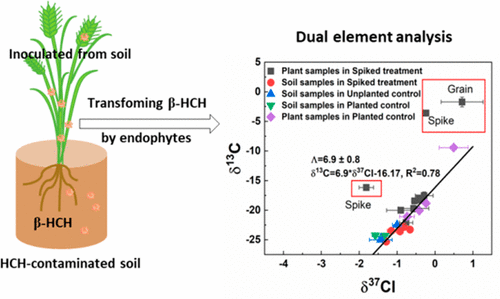当前位置:
X-MOL 学术
›
Environ. Sci. Technol.
›
论文详情
Our official English website, www.x-mol.net, welcomes your
feedback! (Note: you will need to create a separate account there.)
Soil from a Hexachlorocyclohexane Contaminated Field Site Inoculates Wheat in a Pot Experiment to Facilitate the Microbial Transformation of β-Hexachlorocyclohexane Examined by Compound-Specific Isotope Analysis
Environmental Science & Technology ( IF 10.8 ) Pub Date : 2021-10-05 , DOI: 10.1021/acs.est.1c03322 Xiao Liu 1 , Wang Li 1, 2 , Steffen Kümmel 1 , Ines Merbach 3 , Utkarsh Sood 4 , Vipin Gupta 5 , Rup Lal 4 , Hans H Richnow 1
Environmental Science & Technology ( IF 10.8 ) Pub Date : 2021-10-05 , DOI: 10.1021/acs.est.1c03322 Xiao Liu 1 , Wang Li 1, 2 , Steffen Kümmel 1 , Ines Merbach 3 , Utkarsh Sood 4 , Vipin Gupta 5 , Rup Lal 4 , Hans H Richnow 1
Affiliation

|
β-Hexachlorocyclohexane (β-HCH) is a remnant from former HCH pesticide production. Its removal from the environment gained attention in the last few years since it is the most stable HCH isomer. However, knowledge about the transformation of β-HCH in soil–plant systems is still limited. Therefore, experiments with a contaminated field soil were conducted to investigate the transformation of β-HCH in soil–plant systems by compound specific isotope analysis (CSIA). The results showed that the δ13C and δ37Cl values of β-HCH in the soil of the planted control remained stable, revealing no transformation due to a low bioavailability. Remarkably, an increase of the δ13C and δ37Cl values in soil and plant tissues of the spiked treatments were observed, indicating the transformation of β-HCH in both the soil and the plant. This was surprising as previously it was shown that wheat is unable to transform β-HCH when growing in hydroponic culture or garden soil. Thus, results of this work indicate for the first time that a microbial community of the soil inoculated the wheat and then facilitated the transformation of β-HCH in the wheat, which may have implications for the development of phytoremediation concepts. A high abundance of HCH degraders belonging to Sphingomonas sp., Mycobacterium sp., and others was detected in the β-HCH-treated bulk and rhizosphere soil, potentially supporting the biotransformation.
中文翻译:

六氯环己烷污染现场土壤在盆栽试验中接种小麦,促进β-六氯环己烷微生物转化化合物特异性同位素分析
β-六氯环己烷 (β-HCH) 是前六氯环己烷农药生产的残余物。由于它是最稳定的六氯环己烷异构体,因此在过去几年中从环境中去除它引起了人们的关注。然而,关于 β-六氯环己烷在土壤-植物系统中转化的知识仍然有限。因此,对受污染的田间土壤进行了实验,以通过化合物特异性同位素分析 (CSIA) 研究 β-六氯环己烷在土壤-植物系统中的转化。结果表明,种植对照土壤中 β-HCH的 δ 13 C 和 δ 37 Cl 值保持稳定,表明由于生物利用度低而未发生转化。值得注意的是,δ 13 C 和δ 37 的增加观察到加标处理的土壤和植物组织中的 Cl 值,表明 β-HCH 在土壤和植物中都发生了转化。这是令人惊讶的,因为之前的研究表明,小麦在水培栽培或花园土壤中生长时无法转化 β-六氯环己烷。因此,这项工作的结果首次表明,土壤微生物群落接种了小麦,然后促进了小麦中 β-六氯环己烷的转化,这可能对植物修复概念的发展产生影响。在 β-六氯环己烷处理过的大块土壤和根际土壤中检测到大量属于鞘氨醇单胞菌属、分枝杆菌属等的六氯环己烷降解剂,可能支持生物转化。
更新日期:2021-10-19
中文翻译:

六氯环己烷污染现场土壤在盆栽试验中接种小麦,促进β-六氯环己烷微生物转化化合物特异性同位素分析
β-六氯环己烷 (β-HCH) 是前六氯环己烷农药生产的残余物。由于它是最稳定的六氯环己烷异构体,因此在过去几年中从环境中去除它引起了人们的关注。然而,关于 β-六氯环己烷在土壤-植物系统中转化的知识仍然有限。因此,对受污染的田间土壤进行了实验,以通过化合物特异性同位素分析 (CSIA) 研究 β-六氯环己烷在土壤-植物系统中的转化。结果表明,种植对照土壤中 β-HCH的 δ 13 C 和 δ 37 Cl 值保持稳定,表明由于生物利用度低而未发生转化。值得注意的是,δ 13 C 和δ 37 的增加观察到加标处理的土壤和植物组织中的 Cl 值,表明 β-HCH 在土壤和植物中都发生了转化。这是令人惊讶的,因为之前的研究表明,小麦在水培栽培或花园土壤中生长时无法转化 β-六氯环己烷。因此,这项工作的结果首次表明,土壤微生物群落接种了小麦,然后促进了小麦中 β-六氯环己烷的转化,这可能对植物修复概念的发展产生影响。在 β-六氯环己烷处理过的大块土壤和根际土壤中检测到大量属于鞘氨醇单胞菌属、分枝杆菌属等的六氯环己烷降解剂,可能支持生物转化。











































 京公网安备 11010802027423号
京公网安备 11010802027423号